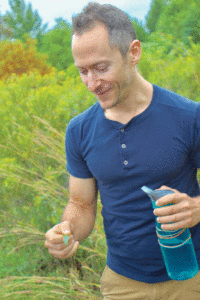
One of Shane Brill’s focal points at the Chestertown-based Eastern Shore Food Lab is the responsible use of plants for food, medicinal, and aesthetic purposes permaculture systems.
Shane Brill likes to begin each day by tasting something brand new.
But instead of rummaging in the fridge, or frequenting the local bakery, he forages for novel flavors in and around his own backyard, or while biking to work as the assistant director of the Eastern Shore Food Lab at Washington College in Chestertown.
Brill brought his penchant for wrangling tasty morsels from the largely overlooked natural landscape to an Adkins Arboretum workshop held during the Fall native plant sale in September.
First via photo overview and talk, followed by a “field” walkabout, he helped participants look beyond the familiar attributes of locally growing trees and shrubs — shade and scenic greenery — as sources of sustenance, just as Native Americans, colonial settlers had historically done, and as critters continue to do.
One of these, the graceful Juneberry tree, offers luscious berries, so tasty that you have to be quick to beat the birds to them. (Once you tell your friends how good they are, you’ll have even more competition, Brill added, speaking from experience.)
Another sweet treat comes courtesy of the Pawpaw tree whose unassuming green pods open to orange tinged tropical tasting fruit.
Brill recently gathered 20 pounds of pawpaw he plans to puree and store for use in the Food Lab over the year. He’s also used the fruit to flavor ice cream.
Birch tree trunks can be tapped for syrup, Beech tree leaves can provide tasty salad greens when gathered in early Spring, and have been used this way on campus, he related.
Redbud Trees’ green pods can be cooked, and tiny pink flowers can also be eaten. Magnolia blossoms are palatable when pickled. Ripe Juniper Tree berries supply pungent flavor to gin and meat.
Brill shared additional nuggets of eco-epicurean wisdom, including:
• White oak nuts, larger than red oak nuts, contain fewer tannins, and taste better. Squirrels eat those acorns first, burying the red, which incidentally serves to help leach the bitter tannins out.
• Hazelnuts native to America are smaller, and also a squirrel favorite.
• Sassafras leaves can be brewed for tea, or ground into file powder for gumbo. If a tree falls over, the roots can be used for root beer.
• Witch hazel leaves and twigs make good tea; sumac berries, when soaked (not boiled), taste like pink lemonade. Elderberry flowers flavor wine, while the berries make jams and jelly.
• Black Myrtle leaves offer a bay laurel-like seasoning. Monarda (bee balm) leaves can be used to top pizza or infused for a tea.
• Solomon seal shoots can be eaten when young, like asparagus, while Zizea Aurea flowers are munched like mini broccoli. (Brill’s adopted kitty, the foundling of a friend who works at Adkins, was christened Zizea to commemorate her native roots.)
Next, it was onto the “wilds” of the Arboretum grounds to discover firsthand the almost endless edible possibilities in the easily accessible surrounding vegetation.
Despite romantic notions of trudging deep into dark woods to scavenge, the “good stuff” is almost always readily available near the edges, where there’s more light, Brill advised.
Lemony tasting wood sorrel — rich in vitamin C and resembling clover — is used to garnish and flavor fish, and is among the safest to sample, so Brill plucked a few for participants who chose to nibble.
Later, pepper weed pods, members of the mustard seed family, were also tried.
Folks got to see firsthand how to pick a proper Juniper berry — the darker blue ones are ripe, the light, first year growth, too bitter and to be avoided.
Eventually Monarda leaves appeared and were eagerly sniffed and tasted, meeting with universal approval.
When participants encountered Milkweed, the Monarch Butterfly’s primary form of sustenance, they learned the young “silk” from its pods could be used as a cheese substitute. USDA literature cites the Native American practice of boiling the young shoots, stems, flower buds, immature fruits, and roots and consuming as a vegetable.
Coming upon Mugwort the group learned of its use as a light addition to salads and an ingredient in beer, also that a variety of cultures contained a common lore about its leaves, stuffed into bed pillows, would lead to vivid dreams.
For those contemplating foraging for the first time, Brill agreed to share his “general rules of thumb,” including bringing an experienced guide along, or at least a reliable guidebook, and proceeding slowly and with caution.
“First take a little bit of the plant, rub it on your skin, then wait at least 20 minutes in case of a reaction,” Brill said. “Next, rub it on your lips, and wait another 20 minutes.
“Bite a tiny piece and hold it in your mouth, then spit it out, and wait 20 minutes. Only then should you eat it. The key is to proceed slowly, in moderation.”




